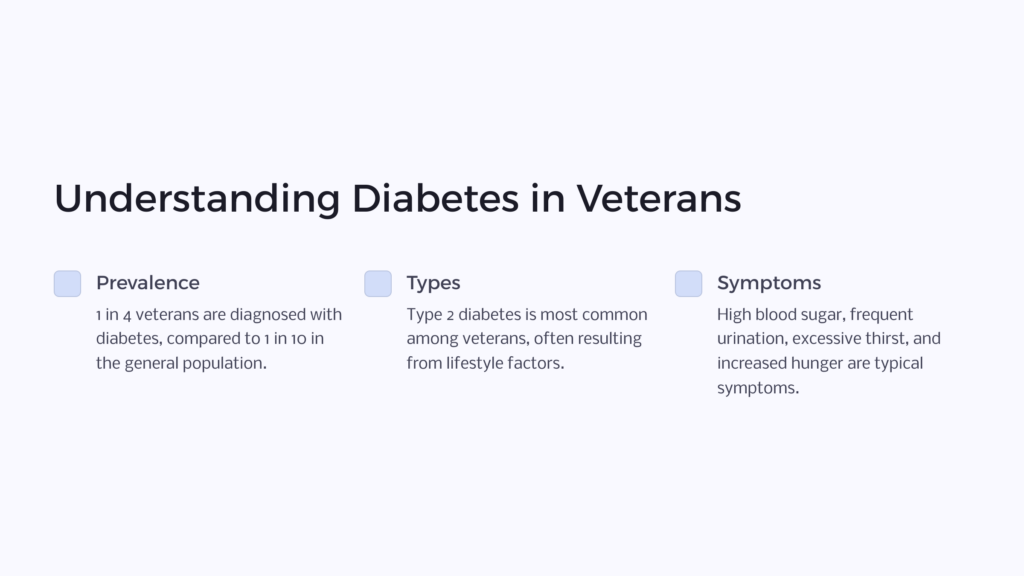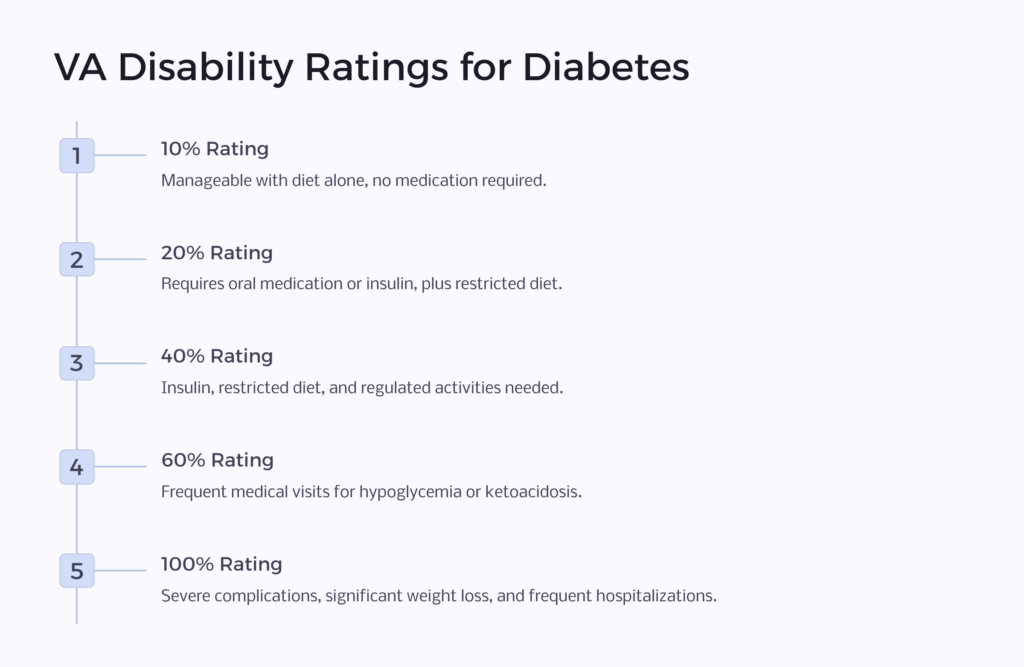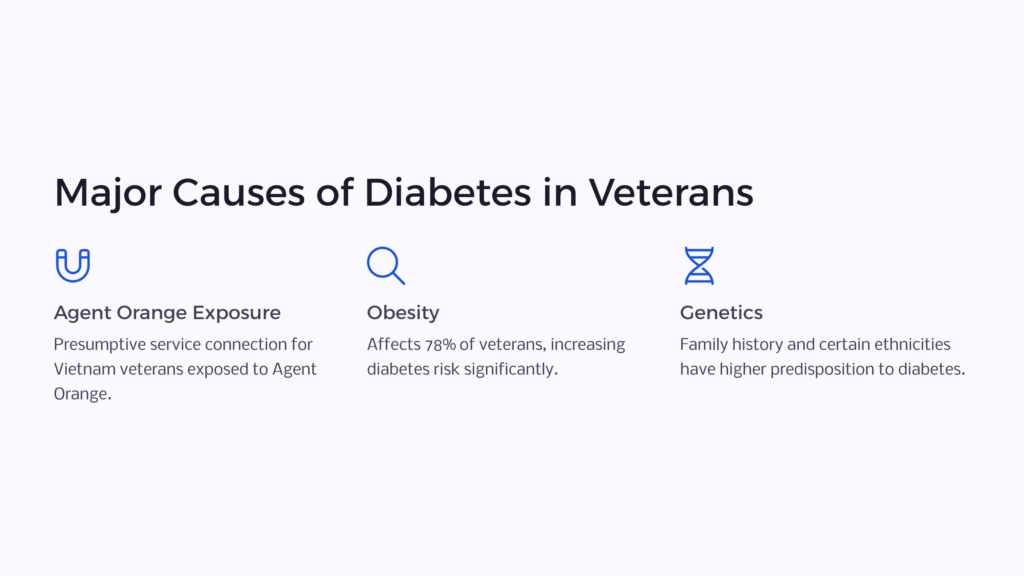Diabetes affects a higher percentage of United States military veterans than the country’s general population. While many factors can lead to type 2 diabetes in veterans, Agent Orange exposure and obesity tend to be the most influential factors in any service member with any medical condition diagnosed during this time. Veterans can receive a VA disability rating and social security disability insurance for their condition if their diabetes is determined to be connected to their service.
What Is Diabetes?

Diabetes mellitus is a prevalent condition across the United States. The most recent data states that more than 1 in 10 Americans have diabetes, and about 88 million have prediabetes, a precursor to the condition. The condition is even more common among veterans, with as many as 1 in 4 currently diagnosed with diabetes.
Diabetes affects how the body processes blood sugars—also known as glucose—due to insulin resistance or not enough insulin being produced. Having too much glucose in the blood can cause several other health problems, such as vision issues like diabetic retinopathy, heart disease, peripheral neuropathy, erectile dysfunction, and kidney failure.
There are three forms of diabetes: gestational diabetes, type 1, and type 2. Gestational diabetes occurs in pregnant women who do not already have diabetes. Type 1 is a genetic condition that is usually diagnosed in childhood and is characterized by the body’s inability to produce any or enough insulin. Type 2 diabetes often occurs later in life, usually as a result of lifestyle habits, like not enough physical activity or a poor diet. Stress, age, alcohol consumption, and smoking can also play a role.
Type 2 diabetes is typically characterized by high blood sugar, frequent urination, excessive thirst, and increased hunger. This form of diabetes is especially prominent within the veteran community. According to one peer-reviewed study, the veteran population has a high incidence of obesity, which is a primary contributing factor to diabetes.
How the VA Rates Diabetes Mellitus Type 2 (Type II Diabetes)

To get VA disability benefits for diabetes, a veteran typically needs to prove that their diabetes is service-connected. That means that it either occurred or was made worse from the veteran’s time in the service. In some cases, a secondary service connection can also lead to VA compensation. Once the VA determines a service connection, it will assign a VA disability rating to the veteran that influences their compensation and benefits.
A VA diabetes rating is no different from other VA disability ratings. The amount of compensation for each disability rating is updated annually. You can view 2023 VA ratings to get an idea of what each VA diabetes rating pays.
The following disability ratings are the most common ones given to veterans with type II diabetes.
10% Rating for Diabetes
The VA considers several factors regarding a veteran’s diabetes service-connected disability claim before giving a VA diabetes rating. First and foremost, the veteran’s blood sugar control is considered. The VA looks at medical reports and blood test results to determine how well a veteran can control their blood sugar through a healthy diet and lifestyle.
A 10% rating is the lowest VA diabetes rating, typically reserved for veterans who can manage their blood sugars without medication. Veterans who have just been diagnosed with diabetes or those who eat well and stay active may fall under this category. Veterans who have other complications stemming from their diabetes or who need medications to control their blood sugar will not be eligible for a 10% disability rating.
While a 10% rating does pay monthly disability benefits, it yields the lowest pay of all disability ratings for diabetes. Still, if a disabled veteran’s condition worsens, they may be eligible for an increased rating at a later date.
20% Rating for Diabetes
A 20% VA diabetes rating goes to veterans who cannot manage their high blood sugars through a restrictive diet alone. This rating is assigned to veterans who take oral medication combined with a restrictive diet or those who need insulin at least once a day to manage their diabetes.
Once a person has begun taking insulin to manage their diabetes, their condition may have progressed to the point where other side effects occur. Taking insulin can be tricky, as it needs to be taken at the appropriate time and in the right dosage to prevent low blood sugar, according to Medical News Today. Side effects from insulin also include initial weight gain, injection site irritation, and anxiety or depression.
Veterans should track any changes to their health after starting a medication regimen for diabetes and stay in contact with their doctor and the VA to report changes. As with a 10% rating, a 20% rating can increase if the veteran experiences enough changes.
40% Rating for Diabetes
Once a veteran requires regulated daily activity in addition to a restricted diet and an insulin regimen, they may be granted a 40% VA rating. The regulated daily activity helps to prevent drops in blood sugar. This means that a veteran may need to be put on a specific exercise program while monitoring their blood sugars regularly or avoiding strenuous exercise that tends to drop blood sugar levels.
At this level, a veteran with diabetes typically experiences more day-to-day interferences from their condition due to their regulated activities. They might also experience secondary conditions related to diabetes, like diabetic neuropathy, fungal infections, or depression. When seeking disability pay for diabetes, veterans should be sure to submit medical evidence for any potentially related conditions with their VA disability claim.
When going from a 20% rating to a 40% rating, the increase in disability pay more than doubles for a single veteran.
60% Rating for Diabetes
A 60% VA diabetes rating is given to veterans who fall within the criteria of a 40% rating but also require increased visits to their diabetic care team or hospital due to hypoglycemic reactions or ketoacidosis. More specifically, the VA requires at least twice a month visits to a diabetic specialist or two visits a year to a hospital due to either of these conditions to receive a 60% rating.
According to the American Diabetes Association, a hypoglycemic reaction refers to a significant drop in blood sugar below the healthy range. Hypoglycemia can cause shakiness, nausea, weakness, confusion, and seizures.
Ketoacidosis is a condition that results from high levels of ketones in the body. This can be life-threatening, but early warning signs include difficulty breathing, fatigue, frequent urination, and nausea or vomiting.
Additionally, veterans receiving this rating may have other complications that the VA wouldn’t normally evaluate separately, like hypertension, foot problems related to diabetes, and retinopathy.
100% Rating for Diabetes
A 100% VA diabetes rating is the highest that a veteran can receive for this or any other condition. For this rating, diabetes will have had to progress to the point of the veteran experiencing significant weight or strength loss due to diabetes complications. Additionally, they must meet the criteria from previous ratings, including a restricted diet, daily insulin injections, and regulated activity.
According to the Cleveland Clinic, unexpected weight loss can occur with type 2 diabetes because the body makes up for its lack of cell glucose to burn energy. Instead, it burns fat and muscle while the kidneys overcompensate to remove blood sugar. These unusual situations can lead to quick weight loss when diabetes isn’t controlled properly.
Veterans with this rating must also experience ketoacidosis or hypoglycemic reactions that result in hospital visits or more frequent diabetic specialist appointments.
Why Do So Many Veterans Have Diabetes?

Diabetes affects a wide population of veterans for many reasons. The following are some of the most common causes of diabetes in veterans that could make military service members eligible for VA disability benefits.
Agent Orange
Agent Orange is a herbicide that was used mostly during the Vietnam War. At the time, the United States military was unaware of the toxic side effects that Agent Orange exposure could cause military service members. Since then, medical specialists and the military have confirmed that several health conditions that affect any Vietnam veteran could have ties to Agent Orange exposure.
The VA presumes that any Vietnam veteran that has been exposed to Agent Orange has automatically proven a service connection between their conditions and their exposure. This is known as a presumptive disability. Presumptive disabilities usually make it easier for a veteran to receive VA benefits and compensation based on their service connected disability claim.
One such condition is diabetes. Some research has pointed to a possible connection between Agent Orange exposure and type 2 diabetes. Vietnam veterans usually do not need to prove a service connection to their diabetes, as this research has found that dioxin and other chemical compounds in Agent Orange could contribute to the development of diabetes.
The VA will also consider a disability claim of any veteran who did not serve in the Vietnam War if they were also potentially exposed to Agent Orange. Additionally, a veteran does not have to prove a connection to Agent Orange exposure if they have diabetes and want to submit a VA disability claim.
A disabled veteran with Agent Orange exposure may also qualify for special monthly compensation (SMC) from the VA, depending on the severity of additional disabilities with provided medical evidence.
Obesity
Obesity is a leading cause of type II diabetes for the general population and affects 78% of the veteran population. Research shows that specific groups of veterans, including younger veterans, Black women veterans, and American Indian/Alaska Native veterans are at a higher risk of developing obesity than others.
While there’s no clear-cut reason why veterans tend to experience obesity at such high rates, studies suggest that veterans sometimes revert to unhealthy lifestyles after leaving the service. One article published in the Annals of Epidemiology found that veterans who reported low physical activity, high fast food intake, inadequate sleep patterns, and smoking or alcohol usage had a higher risk of obesity than veterans reporting healthy behaviors.
According to HonorHealth, when you carry extra weight, your cells may lose sensitivity to the insulin that controls blood sugar because fat cells aren’t as responsive to insulin as muscle cells. Therefore, losing fat and weight can decrease the risk of developing diabetes. If you’re overweight and at risk for diabetes, your doctor will likely recommend trying to lose weight through a healthy diet and exercise regimen, as physical activity will help your body burn fat.
If you already have diabetes, leading a healthier lifestyle can still help. Along with diabetes and obesity often come other conditions, like high cholesterol levels, high blood pressure, and stroke or heart attack risk, according to the American Diabetes Association. Losing weight by making over your diet and adding in more physical activity throughout the day can also positively impact these conditions.
In some cases, a person with diabetes may see significant improvement in their symptoms from dietary and activity changes. If a veteran goes from requiring insulin to managing their diabetes with oral medications, it’s possible for their VA diabetes rating to get reduced.
Genetics
The American Diabetes Association states that genetics plays a much larger role in type 2 diabetes than type 1 diabetes. People can be predisposed to this condition genetically, but something in their environment or lifestyle triggers it, such as poor eating habits or lack of physical activity. Therefore, you might notice that several other people in your family are also diabetic or have prediabetes.
Some races may also experience diabetes type 2 more than others, further noting the genetic relationship of the condition. According to the World Health Organization, Native American populations tend to have more widespread type 2 diabetes than other groups. Hispanic and African American populations follow close behind. India and China lead in the number of diabetes diagnoses per country, but the United States lands third worldwide.
Lack of Exercise
A lack of physical activity can lead to type II diabetes. When we exercise, much more happens to the body than losing weight and burning fat, although it certainly can assist with these processes. Endocrinologist Douglas Zlock tells John Muir Health, “Even if you don’t lose weight, exercise will make you stronger and healthier. Healthy habits can definitely postpone the onset of diabetes even if they don’t prevent it.”
However, exercise also helps manage blood sugar levels, so not getting enough physical activity can cause more glucose in the bloodstream.
Physical activity also affects blood pressure (another risk factor for diabetes). With regular exercise, a person can lower their blood pressure and have more regulated blood pressure numbers across a given period. Exercise also keeps cholesterol levels in a healthy range, raising good cholesterol and lowering bad cholesterol.
Poor Eating Habits
Poor eating habits include eating a diet high in fats and cholesterol, consuming too many calories each day, or incorporating too much sugar or salt into a diet. Diets without the right proportions of nutrition can cause high blood pressure, risk of heart disease, and risk of obesity, all of which may lead to diabetes.
Skipping breakfast, drinking sugary drinks, eating too many carbs, and snacking late at night are not-so-healthy habits that could contribute to diabetes. If you partake in any of these habits, try replacing one at a time with a healthier habit, like drinking more water during the day instead of reaching for an energy drink.
Smoking
Veterans who smoke have a higher risk of developing diabetes than veterans who don’t smoke. Research finds that the habit of smoking increases between military recruitment and active duty, with as many as 38% of smokers picking up the habit after joining the military.
The FDA states that smokers are as much as 40% more likely to develop ty
e 2 diabetes than people who don’t smoke. Nicotine in tobacco can reduce insulin’s efficacy, making it more difficult for the body to manage glucose levels. Over time, this mismanagement can lead to the development of diabetes.
As many as 3 in 10 veterans use tobacco products. Veterans without health insurance, under severe stress, and in a low-income bracket are likelier to use tobacco products than other veterans.
Sleep Disorders/Sleep Apnea
Research has found links between obstructive sleep apnea and type 2 diabetes. Obstructive sleep apnea can cause momentary lapses in breathing during sleep due to the involuntary relaxing of the muscles that help you breathe. The consistent interference with breathing and sleep that comes with sleep apnea and other sleep disorders could lead to irregular blood glucose control.
According to Cleveland Clinic, obstructive sleep apnea’s irregular breathing causes increased carbon dioxide in the blood. Higher levels of carbon dioxide contribute to insulin resistance, which makes it more difficult for the body to use insulin properly.
Carrying excess weight or being obese is a leading cause of sleep apnea, but hypothyroidism, allergies, any medical condition involving the airways, and smoking or alcohol use can also contribute to the situation.
Secondary Service-Connected Conditions
Secondary conditions caused by diabetes may affect a veteran’s VA disability claim, rating, and compensation. Secondary diabetes conditions include:
- High blood pressure
- Kidney dysfunction or failure
- Peripheral neuropathy
- Erectile dysfunction
- Coronary artery disease or other heart conditions
- Foot problems
- Diabetes treatment with medication that exacerbates other issues
If you have any of these secondary conditions as a previous service member and can provide medical evidence for them, you may be able to increase your VA diabetes rating with a rating increase claim. Filing this type of VA claim triggers an extra review by the VA and an additional diagnostic code to add to your current claim and rating. If your rating increases, your compensation could, too.
It’s important to speak with a VA disability attorney to help you decide which type of claim to file and what information to include with your claim for a potential increase to your rating and compensation amount.
VA Diabetes Rating and Compensation
Additionally, secondary conditions relating to diabetes could boost your VA diabetes rating and disability compensation. Conditions like foot infections, kidney dysfunction, and heart problems may relate to your diabetes and, therefore, could be considered by the VA as part of a claim for an increased rating.
It may be beneficial to connect with a medical professional to discuss your situation and condition and determine the best avenue for getting the disability rating and compensation you deserve for your service-connected type II diabetes. Another option is to hire a VA disability attorney who can update you on your claim’s status, and be your main point of contact throughout the claims and appeals processes. If you have any questions or concerns, reach out to a Benefits Advisor today for a free evaluation.

 Benefits.com Advisors
Benefits.com Advisors
With expertise spanning local, state, and federal benefit programs, our team is dedicated to guiding individuals towards the perfect program tailored to their unique circumstances.
Rise to the top with Peak Benefits!
Join our Peak Benefits Newsletter for the latest news, resources, and offers on all things government benefits.


















